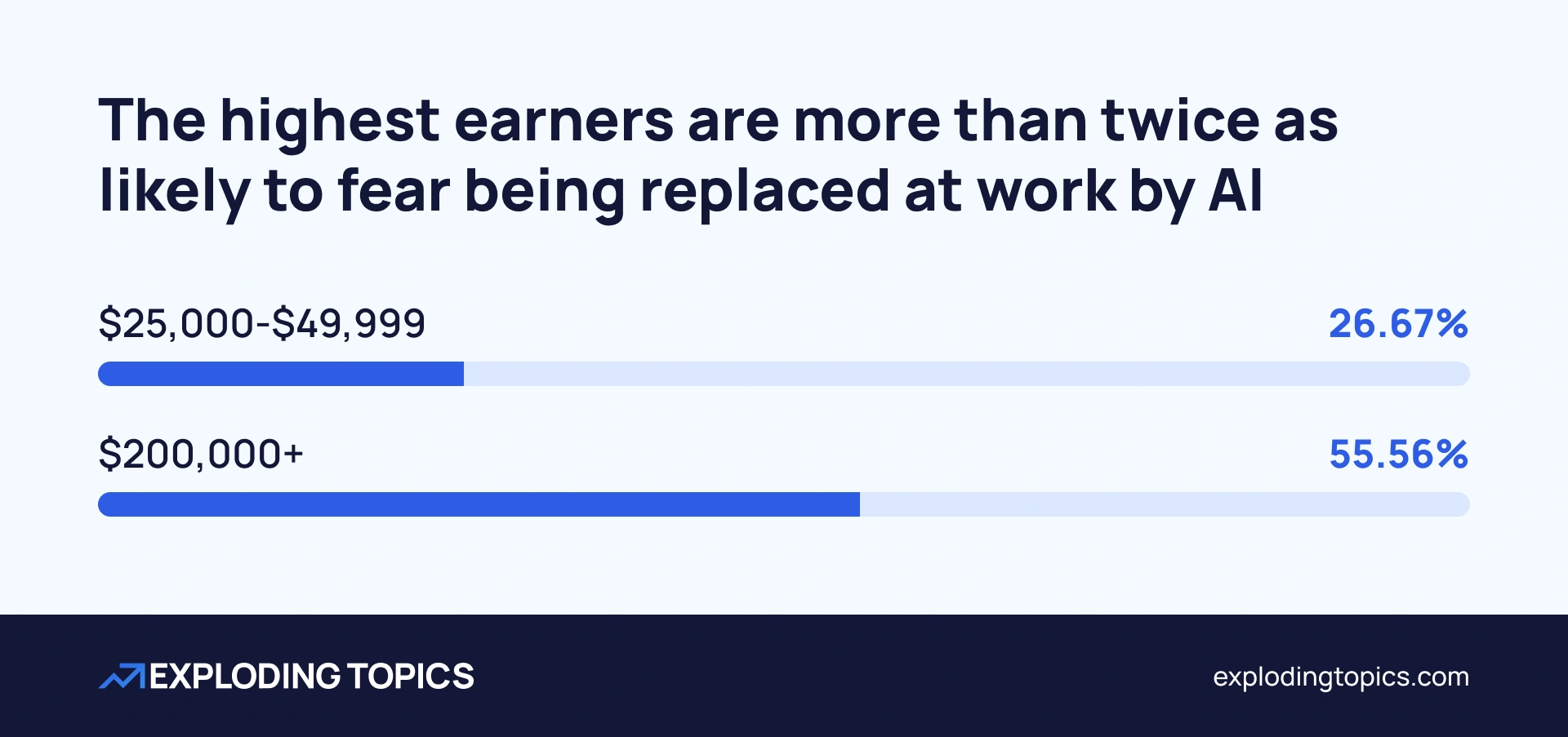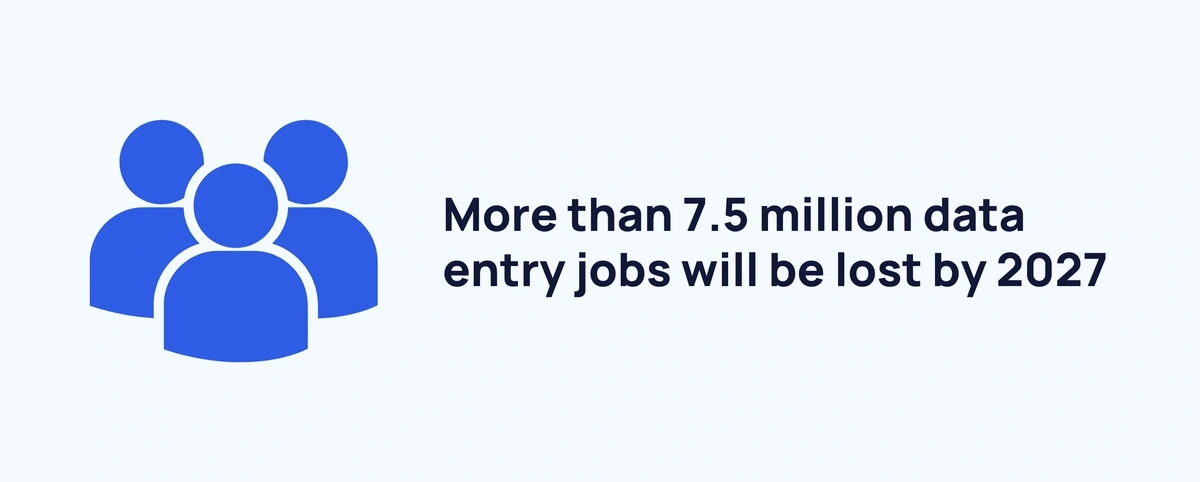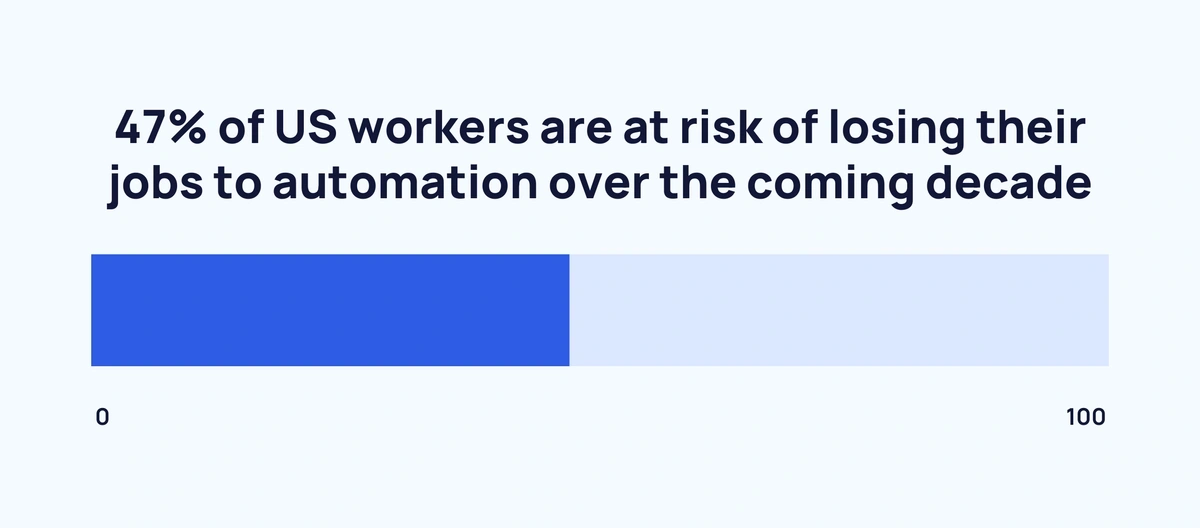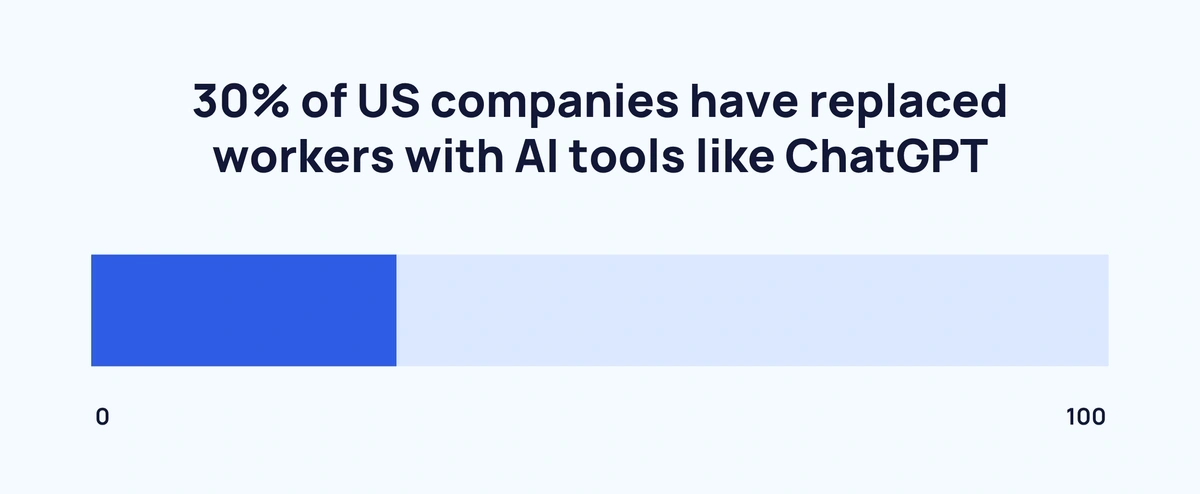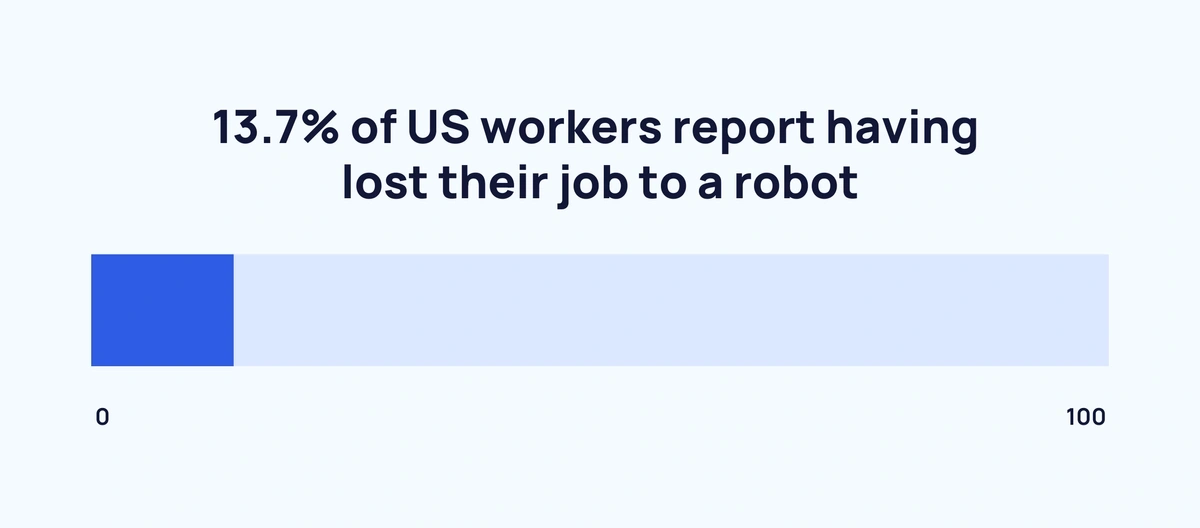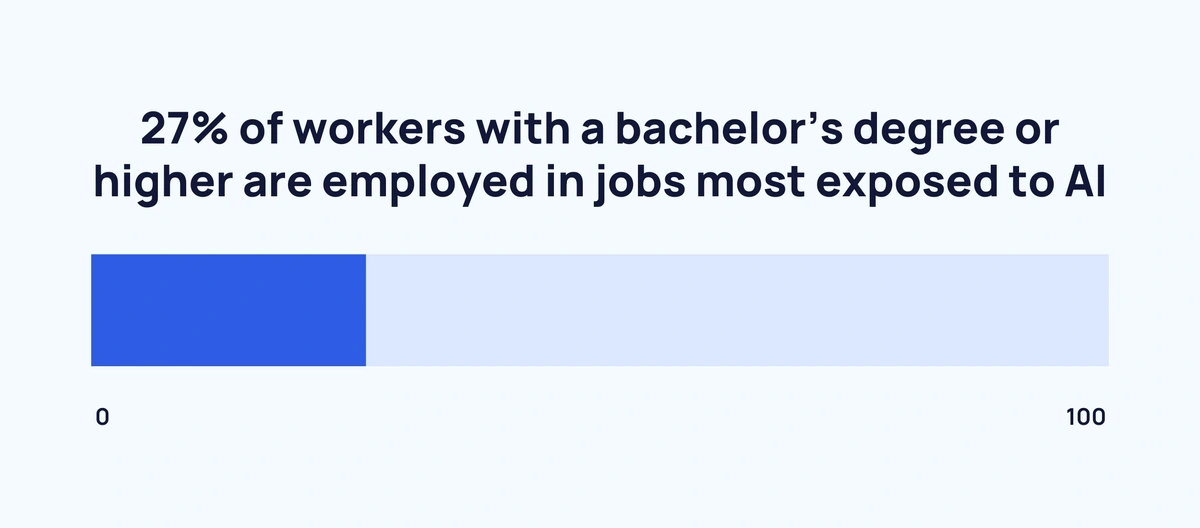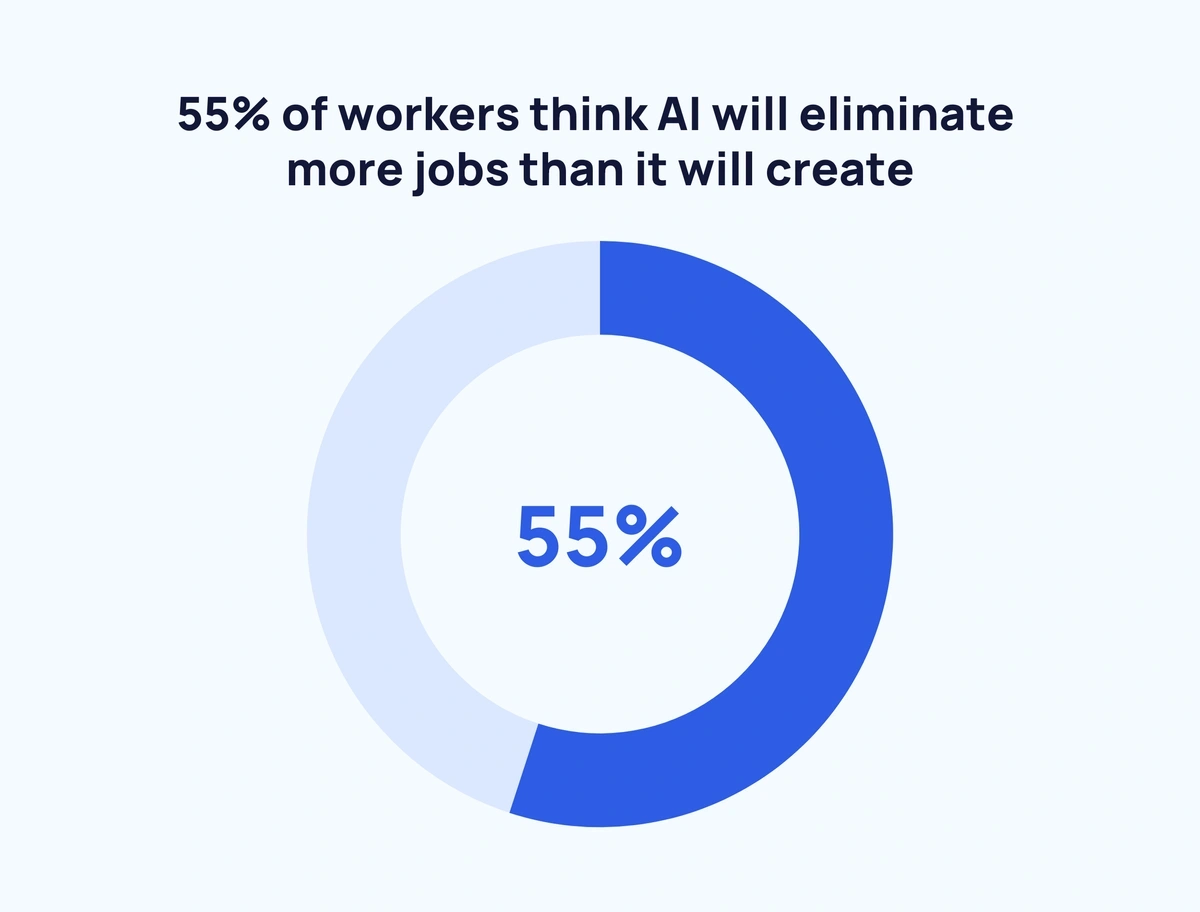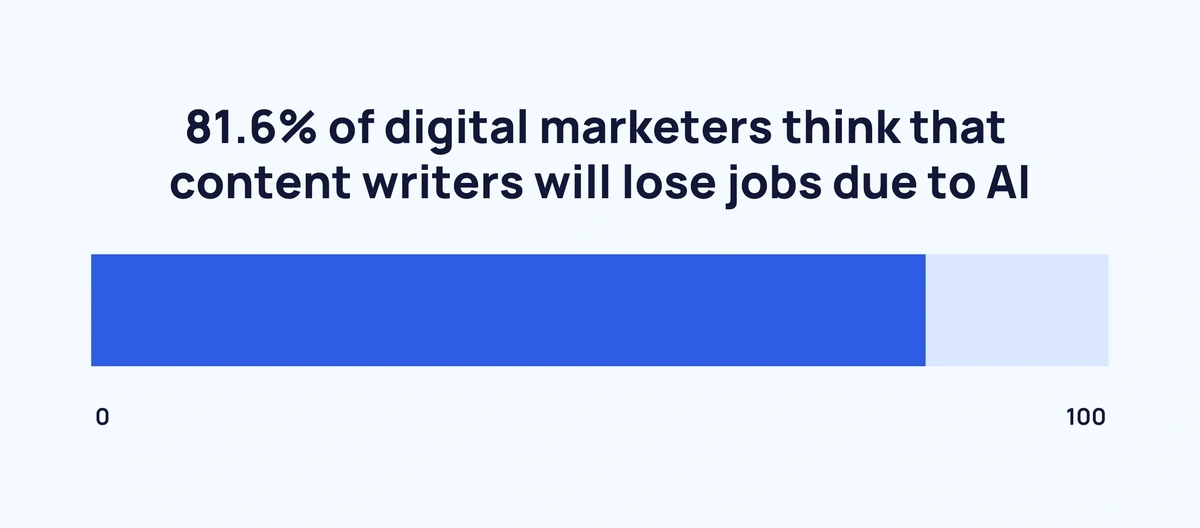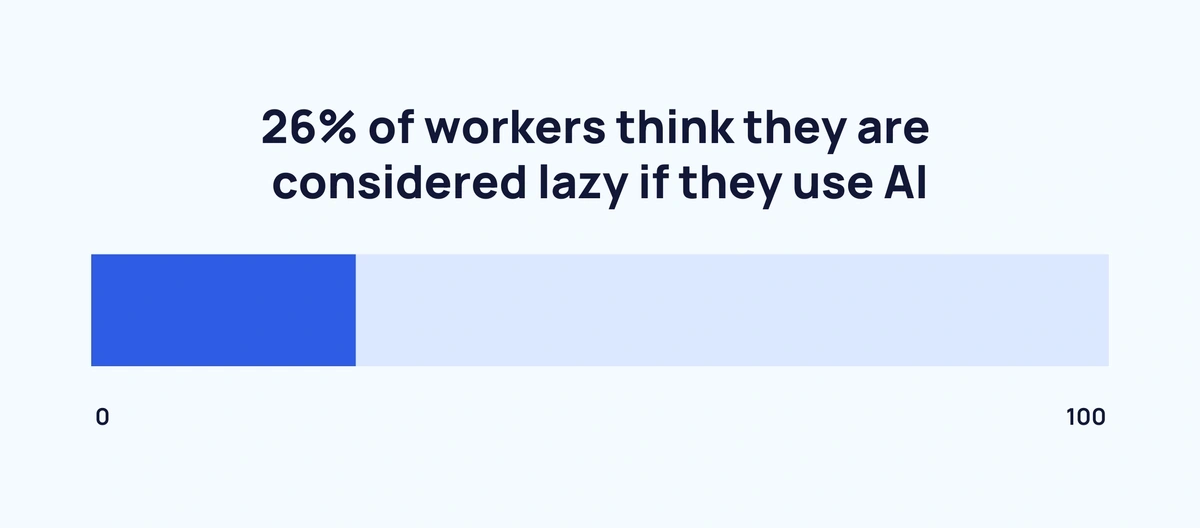
60+ Stats On AI Replacing Jobs (2025)
The year 2025 is adding even more momentum to significant changes AI is already causing to the job market.
As AI tools become increasingly powerful, and with highly anticipated LLM models like ChatGPT 5 likely to be launching for general use soon, more people are at risk of having their job fully automated. Manus, dubbed the first general-purpose AI agent, launched earlier this year.
However, will AI really put most people’s jobs at risk, or is the reality more nuanced?
In this article, we’ll explore dozens of statistics covering the who, what, where, and when of AI replacing jobs—and creating new ones.
Key Statistics About AI Replacing Jobs (Editor’s Picks)
- 300 million jobs could be lost to AI
- AI could force 14% of all workers to change career by 2030
- High earners are most concerned about AI taking their jobs
- 47% of all US workers could see their roles come under threat from AI in the next decade
- Automating half of current tasks worldwide could take another 20 years
- 60% of the jobs in advanced economies are at risk of being replaced by AI
- But just 26% of jobs in low-income countries are similarly exposed
- And only 3% of workers with less than a high school diploma are in work considered "most exposed" to AI job losses
- Workers aged 18-24 are 129% more likely than workers aged over 65 to worry that AI will make their job obsolete
- 15% of workers in the US would consider having an AI boss
AI’s Potential Impact on the Job Market
AI may replace 300 million jobs (Goldman Sachs via BBC)
That represents 9.1% of all jobs worldwide. Potential job losses will not be evenly distributed across different sectors of the economy. Instead, they will likely be concentrated in the professions most vulnerable to being automated via generative AI tools (writing, photography, software development, etc.).
The highest earners are most concerned about AI taking their jobs (Exploding Topics)
We found that the highest earners are most likely to use AI.
In our exclusive research, 72.84% of people with a household income over $200,000 said they use AI “much more” than they did a year ago.
But they're also the workers who feel most at risk of replacement.
Globally, 20 million manufacturing jobs could be replaced by automated tools by 2030 (PatentPC)
Most of these automated tools are robots, not strictly AI, but some of these lost jobs will be replaced with new AI tools.
By 2030, 14% of employees will have been forced to change their career because of AI (McKinsey)
That’s 14% of the global workforce, or 375 million workers. It's little wonder that AI courses to help workers upskill in the new technology are becoming more and more popular.
Wall Street expects to replace 200,000 roles with AI in the next 3 to 5 years (Bloomberg)
A 2025 Bloomberg Intelligence survey of 93 major banks including Citigroup, JPMorgan and Goldman Sachs found that workforces would be cut by an average of 3% by 2030 at the latest. Almost 1 in 4 executives expect reductions of 5 to 10%.
75% of CEOs think generative AI will significantly change their business within the next three years (PwC)
A large majority of business leaders polled by PwC foresaw the need for training in new skills, improving cybersecurity protocols, and a host of other changes — all due to the introduction and adoption of generative AI.
80% of the US workforce could have at least 10% of their tasks impacted by large language models (ARXIV)
Practically every job involves some tasks that are vulnerable to being automated by AI. Only a small minority of workers are totally unexposed to AI.
More than 7.5 million data entry jobs will be lost by 2027 (WEF)
This represents the largest predicted loss of jobs of any profession. The professions that are predicted to lose the most jobs are those extremely vulnerable to AI. Data entry clerks was first, administrative secretaries was second, and accounting was third.
41% of employers worldwide intend to reduce their workforce because of AI in the next five years (World Economic Forum)
The 2025 Future of Jobs report found that 92 million roles could be displaced by 2030, although it forecast a net gain of 78 million new jobs.
47% of US workers are at risk of losing their jobs to automation over the coming decade (CEPR)
In this case, automation also includes non-AI tools like robots.
It will take at least 20 years to automate just half of current worldwide work tasks (McKinsey)
While the potential economic gains from automation are great, they are a difficult potential to fully realize. Various barriers prevent widespread adoption of automation tools; these barriers, which can be legal, political, economic, social, technological, or something else entirely, may take decades to overcome.
AI’s Current Impact On the Job Market
30% of US companies have replaced workers with AI tools like ChatGPT (Resume Templates)
According to a Resume Templates survey of nearly 1,000 US business leaders, 90% of companies have already adopted AI. This year, the amount of companies replacing workers with AI could rise to 38%.
Want to Spy on Your Competition?
Explore competitors’ website traffic stats, discover growth points, and expand your market share.
From January to early June 2025, 77,999 tech job losses were directly linked to AI (Final Round AI)
Cuts at Amazon and Microsoft among others contributed to 491 people losing their jobs to AI every day.
40% of companies that are adopting AI are automating rather than augmenting human work (CNN)
That's according to the CEO of AI giant Anthropic, who also notes that the ratio is moving further toward automation.
Since 2000, automation has resulted in 1.7 million manufacturing jobs being lost (BuiltIn)
The introduction of automotive tools is also linked with increased competition, lower wages, and other negative effects beyond job loss.
13.7% of US workers report having lost their job to a robot (Socius)
AI has already displaced hundreds of thousands of workers. Additionally, people who were replaced by a robot gave a far higher estimate of the proportion of workers who have experienced the same when compared to workers who had not lost their job to a robot. Those who had been replaced estimated that 46.9% of US workers had experienced the same, while people who hadn’t been replaced estimated that 29% of workers had been replaced. Both groups still wildly overestimated the true number of workers who had lost their job to a robot.
Which Careers Are Exposed to AI?
Two-thirds of all jobs in the US and Europe are exposed to automation (Goldman Sachs)
That doesn’t mean these jobs are all going to be fully automated. Exposure to automation just means that some of the tasks involved in a particular career can be automated.
40% of jobs worldwide are exposed to AI (IMF)
Hundreds of millions of people still lack access to the internet. As technology continues to spread around the world, the proportion of workers exposed to AI — and therefore to being automated — may well increase.
60% of jobs in advanced economies could be impacted by AI (IMF)
“Impacted” is a deliberately neutral term. According to the IMF’s report, about half of those impacted by AI will be benefited. The other half will be negatively impacted. For example, their wages might decrease, or they could outright lose their job.
19% of workers are employed in the jobs most exposed to AI (Pew)
To calculate which jobs were most exposed to AI, researchers at Pew ranked professions based on how much workers relied on tasks that could be fully automated. The top 25% of jobs, when ranked this way, were considered “most exposed” to AI.
27% of workers with a bachelor’s degree or higher are employed in jobs most exposed to AI (Pew)
Workers with higher levels of educational attainment were more likely to be employed in professions considered most exposed to AI. Just 3% of workers with less than a high school degree worked in the jobs most exposed to AI. That figure rose to 12% for workers with a high school diploma, 19% for those with some college experience, and 27% for those with at least a bachelor’s degree.
Workers in jobs considered most exposed to AI earned $13.3/hr more than those in jobs least exposed to AI (Pew)
Better-paid jobs are currently more at risk of being lost to AI. While workers in the jobs most exposed to AI earned an average of $33.3 per hour, those employed in jobs least exposed to AI earned just $20 per hour on average.
Widespread adaptation of current automation tech could affect half of the world economy (McKinsey)
That represents some 1.2 billion employees and $14.6 trillion in wages. For context, $14.6 trillion is larger than the GDP of all countries bar China and the US, and is more than three times larger than the third-largest GDP.
AI Replacing Work Tasks
34% of all business-related tasks are already performed by machines (WEF)
The remaining 66% of tasks are performed by humans. This represents a minor but significant decrease in the share of tasks being performed entirely by non-humans. The researchers at the WEF suggest this could be due to the fact that AI and other automotive tools often help humans perform tasks more efficiently, rather than performing them independently.
Technology and machines play at least some role in 53% of work tasks (WEF)
The 2025 Future of Jobs report found that only 47% of work tasks are mainly performed by humans alone. 22% are done mainly by machines and algorithms, with the remainder being done by a combination of man and machine.
25% of all work tasks could be done by AI (Goldman Sachs)
Some jobs involve more tasks that could be entirely automated by AI. For example, 46% of the tasks completed in administrative roles and 44% of tasks done by workers in legal jobs could be performed by AI. However, only 6% of tasks performed in construction and 4% of those done by maintenance workers could be done by AI.
19% of US workers could see more than half of their tasks impacted by AI (OpenAI)
In this case, “AI” refers specifically to systems that are equivalent to OpenAI’s GPT-4.
Tasks that are highly exposed to AI are important in 77% of all jobs (Pew)
As things stand, AI is far better at some tasks than others. However, the tasks that it is great at, and therefore is most likely to automate, are important or extremely important in 77% of all jobs.
19% of US workers could have at least half of their tasks impacted by LLMs (ARXIV)
The number of workers who could see the majority of their job automated is relatively small at the minute. However, that 19% still represents hundreds of thousands of people — and will almost certainly grow as AI tools become more advanced.
Employers think 34% of tasks will be fully automated by 2030 (WEF)
That actually represents a significant decrease from 2023 predictions, when employers predicted that 42% of tasks would be wholly automated by 2027. This more conservative estimate could reflect doubts about whether AI tools will continue improving at the pace they have over the last few years.
65% of tasks related to data processing and information could be fully automated by 2027 (WEF)
These were the types of tasks most vulnerable to automation. In comparison, employers surveyed by the WEF predict that just 35% of tasks related to reasoning and decision-making could be automated by 2027.
Notable Jobs and Tasks AI Can’t Replace
AI can only economically replace vision-based tasks accounting for just 0.4% of the total wages earned in the US (MIT)
According to a 2023 study by researchers at MIT, computer-vision AI can only automate tasks that account for just 1.6% of the wages earned by non-agricultural workers in the US. However, in most cases it would actually be more expensive to switch from humans to AI. Researchers estimated that it would be cheaper to replace just 23% of those wages that are automable.
23% of workers are in the jobs least exposed to AI (Pew)
The important tasks in these jobs were those resistant to automation. Take nannies, for example. The most important skills required to care for children are not particularly exposed to AI. That makes the job as a whole less exposed to AI than, for example, mechanical drafters.
40% of jobs in emerging markets are exposed to AI (IMF)
Emerging markets are usually less oriented toward services than established, high-income economies. Therefore, they contain fewer jobs that involve tasks that are automable by AI tools.
Just 26% of jobs in low-income countries are exposed to AI (IMF)
The vast majority of jobs in low-income countries involve tasks that are currently not automable by AI. In part, that’s because significant proportions of workers in low-income countries still work in professions like subsistence agriculture. These roles are automable — just not by AI tools.
63% of business leaders surveyed by CEPR think AI won’t affect employment rates in high-income countries (CEPR)
While 27% think AI will increase unemployment in high-income countries, most respondents were unsure about their answers.
Half of jobs will still be safe from full automation by 2045 (Goldman Sachs)
That being said, 60% of occupations could be impacted by AI as soon as 2030. These professions could see wage pressure as competition rises due to the automation of key tasks.
How People Are Responding to the Threat of AI Replacing Jobs
Over the next three years, 120 million workers will undergo retraining due to AI changing business demands (SEO.ai)
Training is one of the major barriers to the widespread adoption of AI tools. It represents a significant cost burden to any employer considering embracing AI. Nevertheless, tens of millions of workers will be retrained, either to use AI tools or to perform new tasks after old ones are automated by AI.
Build a winning strategy
Get a complete view of your competitors to anticipate trends and lead your market
84% of employees worldwide are receiving significant organizational support to learn AI skills (McKinsey)
Employers who fail to train their workers in AI may find themselves falling behind their competitors. That could drive this statistic higher in coming years.
48% of US workers want more formal Gen AI training from their organization (McKinsey)
Training is the single biggest factor that would see more employees integrate AI into their daily work routines.
AI is the highest priority in the training strategies of companies with more than 50,000 employees (WEF)
Larger companies are more likely to embrace and fully adopt AI tools, which naturally means more of them will have to make AI training a top priority. Various industries also have AI as the highest priority of their training strategies, including IT services, media and entertainment, telecommunications, and electronics.
AI Causing Widespread Worry Among Workers
32% of US workers fear that AI will lead to fewer job opportunities (Pew)
All in all, 52% of workers are worried by AI, compared to just 36% who are hopeful. Only 29% feel excited, while 33% feel overwhelmed.
39% of workers are concerned they won’t receive adequate training in new technology (PwC)
Keeping up with technological change is vital if you want to stay afloat in an increasingly competitive workforce. A significant proportion of workers are worried they won’t receive the training necessary to properly use new tech, including AI tools. The same PwC survey found that employees who believe their skills are scarce are far more likely to ask for a pay rise or promotion, feel satisfied with their job, and switch to a new employer.
24% of workers fear that AI will make their job obsolete (SurveyMonkey / CNBC)
Those who are most concerned are younger workers, workers of color, and workers earning lower wages. The fact that lower-wage workers are more worried is interesting, considering the fact that other research shows that those earning higher wages are statistically more likely to be displaced.
43% of workers expect AI to cause their job to significantly change in the next five years (Survey Monkey)
This isn’t necessarily bad. However, significant job changes often result in increased pressure and stress due to the need to adapt, especially if an employer does not provide retraining.
Just 32% of employees think their company has been transparent about its use of AI (Asana)
Perhaps unsurprisingly, workers are less likely to think this if they are lower down in the business hierarchy. While 44% of executives thought their company has been transparent about its AI usage, only 38% of managers agreed, and that figure fell to 25% among individual contributors.
55% of workers think AI will eliminate more jobs than it will create (BMG)
Despite reassurances from leaders in the AI space, people are still wary of this rapidly evolving technology. Just under half of respondents to the same poll said they thought it was likely that humans would eventually lose control of AI systems altogether.
US unemployment could reach 20% in the next five years (CNN)
That’s the warning from the Anthropic CEO. It echoes fears that AI will not create as many jobs as it displaces.
Who is Most Worried About AI Replacing Their Job
81.6% of digital marketers think that content writers will lose jobs due to AI (SEO.ai)
Content production has been one of the industries most impacted by AI, so it’s no surprise the vast majority of those involved in content creation predict jobs will be lost.
52% of people aged 18-24 are worried that AI will negatively impact their future careers (BMG)
Young workers have the most time ahead of them — time in which AI tools can become even more advanced, and pose even more of a challenge to human workers. For context, just 39% of all respondents in this poll indicated concern about their future career prospects being negatively impacted by AI.
Young workers are 129% more likely to be worried than older workers about AI making their job obsolete (SurveyMonkey)
While 32% of workers aged 18-24 reported being somewhat or very worried that AI will make their job obsolete soon, only 14% of workers aged 65 and over felt worried. Each intermediate age group felt more worried the younger they were, perhaps reflecting the face that younger workers will likely have to compete against successively more powerful AI models.
38% of Asian workers are worried AI will make their job obsolete, compared to just 19% of white workers (SurveyMonkey)
Asian workers were the most worried, while white workers were the least afraid. In the middle, 32% of Black workers and 35% of Hispanic workers reported feeling concerned about AI making their job obsolete.
30% of workers earning under $50,000 per year are worried that AI will soon make their job obsolete (SurveyMonkey)
Interestingly, lower-income workers were almost twice as likely as higher earners to be worried about AI eliminating their jobs. Just 16% of workers earning over $150,000 reported feeling this stress.
Fully remote workers are 42% more likely than fully in-person employees to believe their job will be disrupted by AI (SurveyMonkey)
While 54% of fully remote workers think that their job will likely be changed by AI, only 38% of employees who work fully in-person think the same.
51% of workers in advertising and marketing believe their jobs will change due to AI (SurveyMonkey)
This represents one of the highest proportions of workers predicting job changes of any industry. AI tools are already being used by some companies to promote their products.
Where AI is Being Adopted
Companies with annual revenue of at least $500 million are adopting AI more quickly than smaller organizations (McKinsey)
Adopting AI comes with often significant costs. Larger organizations that can absorb these upfront expenses are thus more able and likely to adopt AI tools. According to the 2025 State of AI report, these larger companies tend to use AI in more areas of the business.
More than 75% of all organizations now use AI in at least one business function (McKinsey)
Larger companies are adapting more quickly, but AI adoption is already cutting across the majority of industries and businesses.
AI’s Potential to Create New Careers
81% of office workers hold a generally favorable view of AI (SnapLogic)
AI might be taking some of their jobs, but office workers are still overwhelmingly positive about the new technology. More than four-fifths believe it improves their job performance and experience at work.
51% of office workers say AI lets them achieve better work-life balance (SnapLogic)
The utopian promise of AI, spread by major proponents like Elon Musk, is a world where work isn’t necessary at all. For the minute, however, work remains one part of the work-life balance. A majority of workers are using AI to push the scale further toward “life.”
Alternatively, just 6% of workers say AI will lead to more job opportunities in the long run (Pew)
31% predict the technology won't make much difference, while 32% think it will lead to job losses.
Among those using AI chatbots at work, 79% say it allows them to do things at least somewhat more quickly (Pew)
40% answered extremely/very. Only 29% said that AI chatbots had a similarly major positive impact on the quality of their work.
25.6% of organizations surveyed by the WEF expect AI to create jobs (WEF)
The business leaders polled by the WEF were quite divided over AI’s potential impact, indicating the general uncertainty surrounding the ramifications of widespread AI adoption. A little under half of those surveyed believe it will create jobs, while a little under a quarter think it will eliminate jobs on balance. The degree of disagreement over AI’s impact on jobs was higher than for any other change included in the poll.
Between 2023 and 2027, the profession with the largest net job growth worldwide will be “AI and Machine Learning Specialist” (WEF)
All of the professions that topped this ranking were new. That means there are few existing jobs to lose but many to gain, resulting in a huge net growth. The professions with the largest predicted raw growth in jobs were quite unexposed to AI: agricultural equipment operators, heavy truck and bus drivers, and so on. Each of these professions will likely add over two million jobs worldwide by 2027. For comparison, about one million “AI and Machine Learning Specialist” jobs are predicted to appear over the same timeframe.
Having access to an LLM resulted in 15% of employee tasks being completed faster with no loss in quality (ARXIV)
By allowing employees to complete more work in the same amount of time, AI tools might induce employers to cut back on workers.
Miscellaneous Stats About AI Replacing Jobs
17% of British workers think they can often or always tell when they are using an AI (ONS)
Workers are more likely to be confident they can spot an AI if they are male, younger, or with a degree.
26% of workers think they are considered lazy if they use AI (Asana)
While the vast majority of workers aren’t worried about using AI tools, a significant proportion worry it could negatively impact how people view their work ethic. That’s not an unreasonable concern, as being considered lazy could mean being passed up for a pay rise or promotion.
18% of workers feel like a fraud when they use AI for work (Asana)
Debates around the proper use of AI continue. The direction of popular culture will have a significant impact on this statistic. Will people accept the use of AI for work, or make it unacceptable?
15% of US workers are open to having an AI boss (Asana)
Americans are apparently more receptive to the idea of having a robot boss than British workers. Just 8% of workers in the UK said they’d be open to this idea.
One-third of all US jobs created in the last quarter-century didn’t exist before (McKinsey)
Technically, these jobs either didn’t exist or “barely existed.” Technological advancements can eliminate jobs, but they often create entirely new professions that no one could have predicted.
Conclusion
With AI still advancing so rapidly, even experts are in disagreement about the exact effect this new technology will have on global employment.
On the one hand, AI may well lead to widespread job losses. However, it’s already improving the work lives of millions of employees.
On the other hand, AI is set to create hundreds of thousands of new jobs. And yet millions of people have already been replaced by robots.
Regardless, as AI continues to advance and be adopted, its impact on the global workforce — positive or negative — will only increase.
Stop Guessing, Start Growing 🚀
Use real-time topic data to create content that resonates and brings results.
Exploding Topics is owned by Semrush. Our mission is to provide accurate data and expert insights on emerging trends. Unless otherwise noted, this page’s content was written by either an employee or a paid contractor of Semrush Inc.
Share
Newsletter Signup
By clicking “Subscribe” you agree to Semrush Privacy Policy and consent to Semrush using your contact data for newsletter purposes
Written By


Josh is the Co-Founder and CTO of Exploding Topics. Josh has led Exploding Topics product development from the first line of co... Read more


